Frontend as a Service (FEaaS) is a relatively new approach to delivering composable frontend, allowing merchants to skip the groundwork and focus on what matters most – the customer experience. At Alokai, we are proud to be among the pioneers on the Frontend-as-a-Service market!
The approach is particularly popular among enterprises and digitally mature organizations, but all ecommerce businesses can benefit from using a FEaaS solution. It’s cost-efficient, fast, convenient, and can significantly boost time-to-market rates.
But what is Frontend as a Service?
In this article, we’ll explain FEaaS in detail so you know exactly what to expect and what to look for when deciding what’s best for your growing business needs.
What is Frontend as a Service?
FEaaS is a cloud-based composable commerce solution that provides developers with tools, infrastructure, and resources to build and manage ecommerce frontend stores and applications without setting up and maintaining the infrastructure themselves. Frontend-as-a-Service platforms are solution-specific, highly customizable, and are typically tied to a headless content management system (CMS).
A comprehensive Frontend-as-a-Service solution allows ecommerce developers to build, test, and distribute enhanced frontend experiences. With FEaaS, you can build optimized, well-tested, efficient, and consumer-centric interfaces without investing too much time and money in developing a custom-built frontend.
Additionally, Frontend as a Service provides ready integrations, highly performant and customizable UI capabilities, middleware, and hosting. This allows your teams to construct an entire composable commerce tech stack quickly and hassle-free with minimal engagement from your development team.
According to Precedence Research, “The global cloud-native platforms market size was estimated at USD 4.6 billion in 2023 and is projected to hit around USD 52.84 billion by 2033, growing at a CAGR of 27.70% from 2024 to 2033."
Frontend as a Service enables developers to implement all these functions with pre-built modules without developing them from scratch. This cuts out months of repetitive work for your developers, allowing them to focus on building customizations and personalized customer journeys using the ready code base as a foundation.
From our experience, successfully implementing a Frontend-as-a-Service solution can help enterprise ecommerce companies save up to USD 500,000 in development costs and up to 8 months in development time to get to market faster!
The path to FEaaS: Monolithic vs. composable architecture
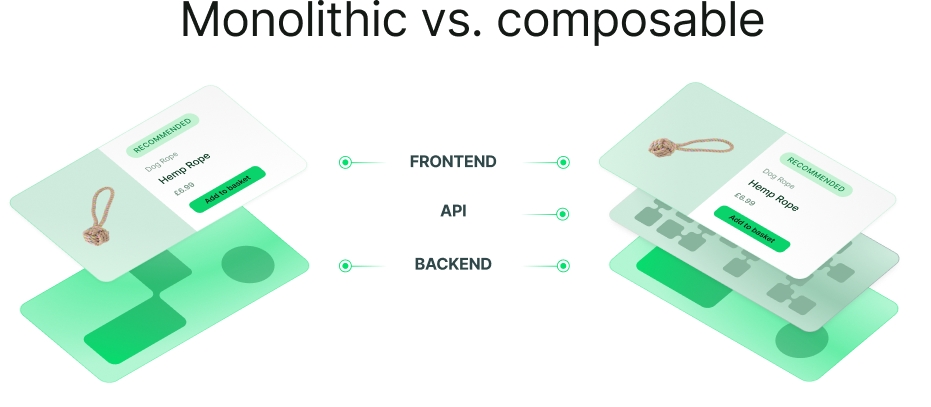
Initially, most ecommerce sites were constructed as a single unit using what's now known as a monolithic architecture. In a monolithic setup the frontend and the backend of your application are tightly coupled together, which means that whenever you introduce changes to one side, it inevitably affects another. While it was a fantastic way to build an online store in the early days of ecommerce, today, it simply can’t keep up with modern consumer demands and ensure optimal performance.
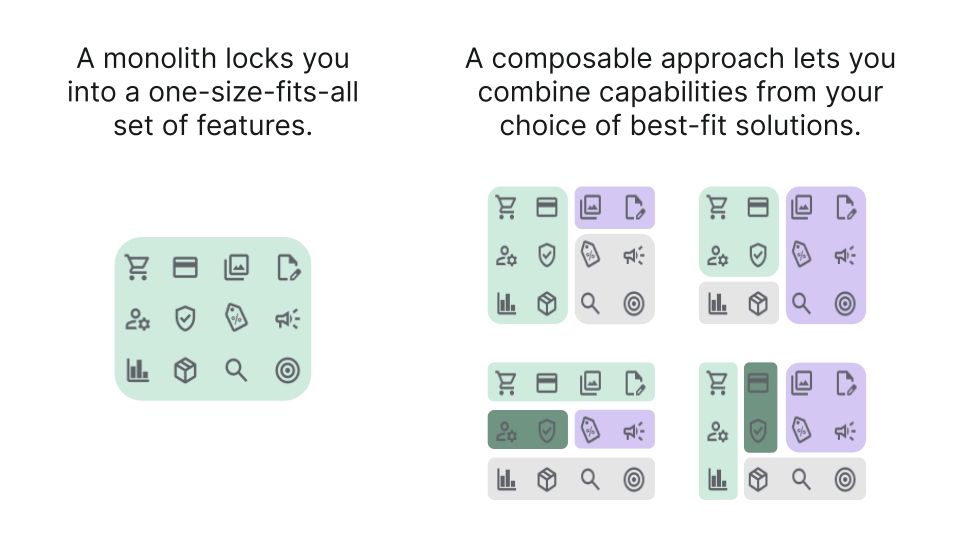
In traditional web development, it takes a significant amount of time and resources to bring your storefront to market and introduce any changes in the future. Modern headless architecture enabled the Frontend-as-as-Service approach that simplifies most of your daily operations making your ecommerce business more agile and scalable than ever before!
The need for complete customization and high-speed infrastructure has led to a modular or composable commerce world. Instead of constructing websites as a single large unit, a composable approach allows you to combine several modules to get precisely the functions and appearance you want.
Some f the challenges monolithic architectures face when compared to composable include:
Limited customization (one size fits all approach).
The frontend UI and backend business logic are tight together, meaning you can't change one without disrupting the other.
Trying to scale any site part can slow down the entire website and negatively affect customer experience.
Composable tech stacks for ecommerce
A composable technology stack allows you to integrate multiple pre-built components in the form of microservices, making one powerful system. Instead of a fixed architecture with limited design possibilities, the website consists of multiple microservices communicating with each other via application programming interfaces (APIs). The result is a high-speed, fully customized composable architecture with many scalable modules.
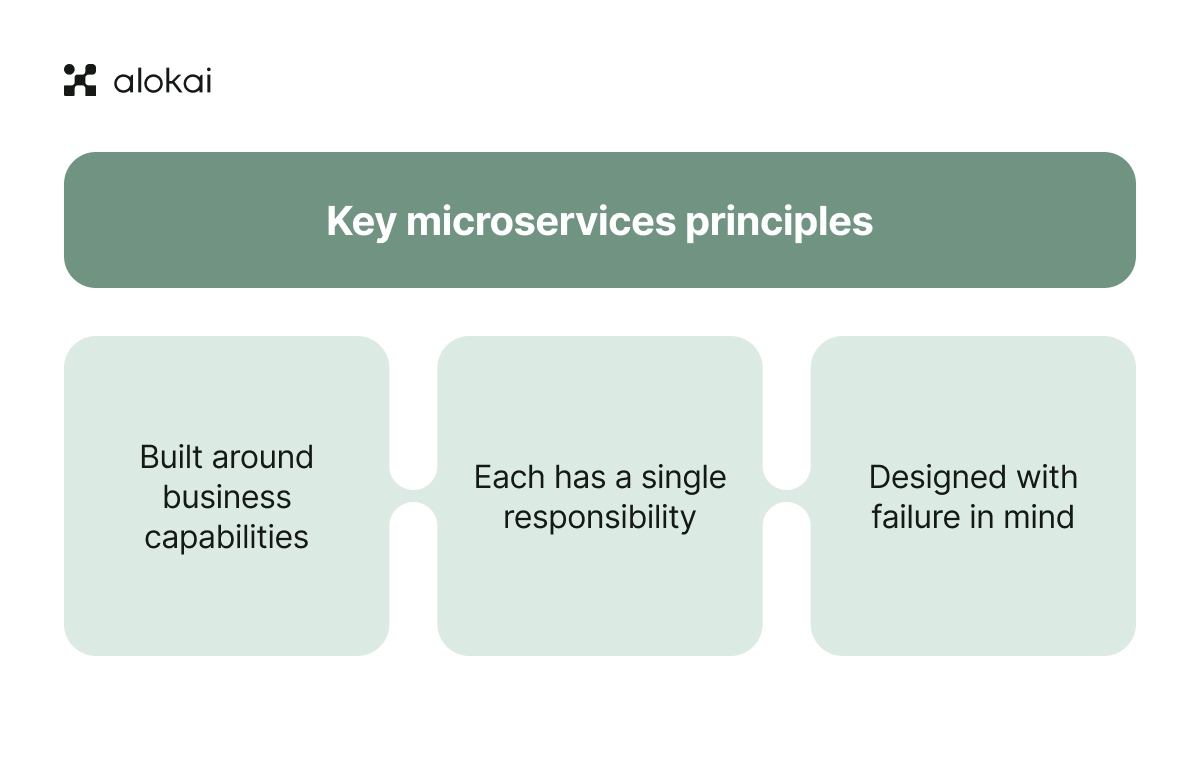
The role of Frontend-as-a-Service in modern ecommerce
Today, ecommerce consumers want seamless omnichannel experiences with responsive design and super-fast delivery times.
As part of Frontend as a Service, it is easy to keep your frontend optimized for performance and mobile compatibility at all times. This gives you a unique and lightning-fast frontend that enhances user and customer experience and improves SEO optimization.
However, one of the greatest struggles for ecommerce stores is that many sites were initially optimized for desktop devices. As we are now in the mobile-first era, many companies struggle with delivering the best experiences for mobile users.
It's a severe customer pain point that often results in a loss of sales for the business. That’s why it’s important for ecommerce businesses to consider cross-platform availability – especially mobile.
What is included in a Frontend as a Service?
Frontend as a Service makes developing headless frontend quicker and easier, by providing you core frontend components and all the essential third-party integrations out of the box without sacrificing the flexibility like a typical SaaS solution would.
Here is an overview of some typical FEaaS components on the example of Alokai's architecture:
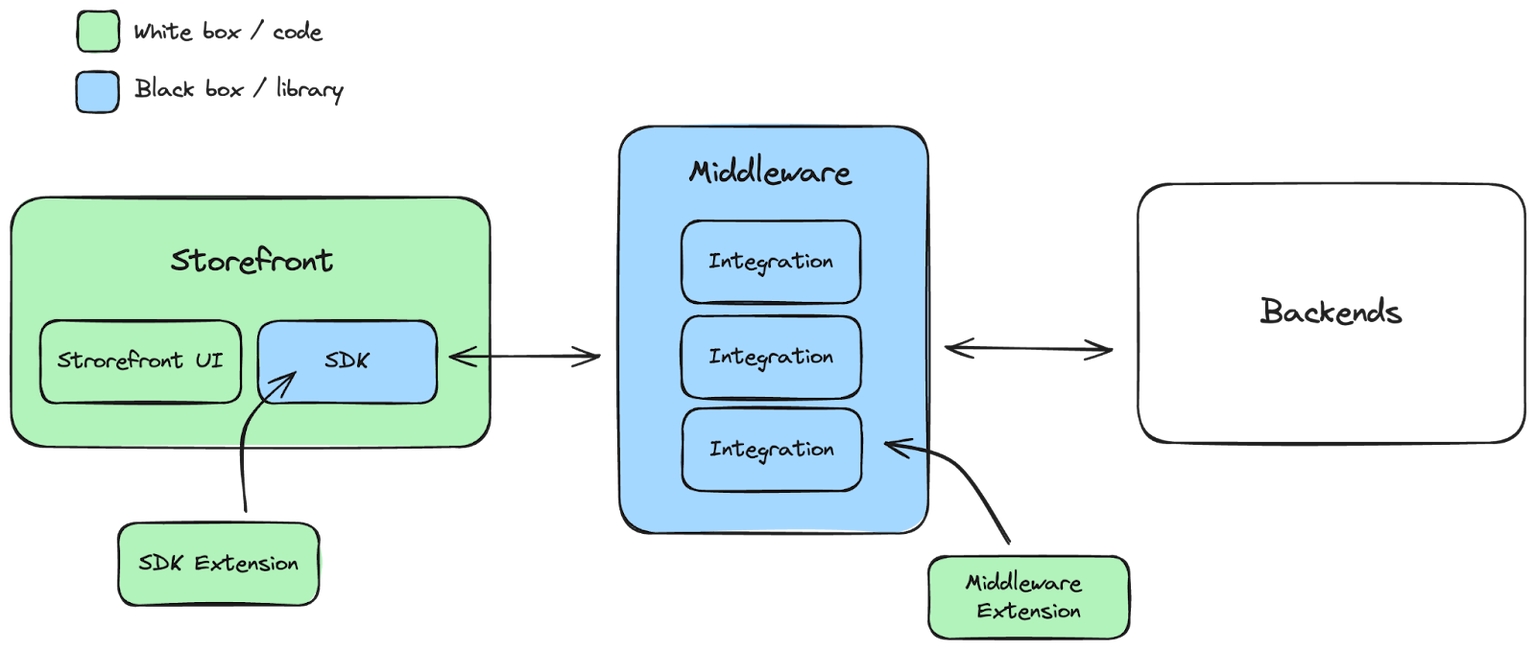
As such, FEaaS comes with:
Premade frontend components to build faster stores;
API and data orchestration layer (the middleware);
Third-party integrations with composable tools of your choice;
Production-ready cloud environment to faciliate hosting.
Don’t worry, we’ll dissect each of them for you.
Pre-built frontend components to build faster stores
Frontend-as-a-Service platforms provide a library of pre-built user interface components like buttons, forms, navigation menus, sliders, and more. These components are ready to use and customizable to match the design and functionality requirements to build headless commerce online stores.
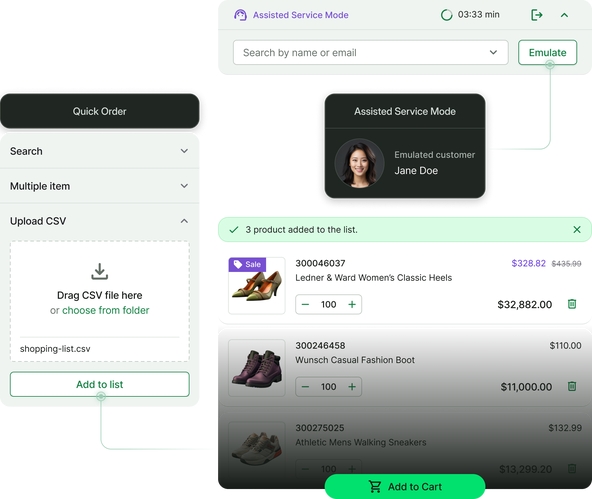
Essentially, you get the core components out of the box, while maintaining the flexibility not to add (and pay for) functionalities you won't be using in the nearest future. At the same time, whenever you decide to scale, you'll still have access to those components to add them without a hassle.
API and data orchestration layer
The best Frontend-as-a-Service solutions offer an API orchestration layer. This layer facilitates communication between different composable tools in your ecommerce stack, orchestrates the data, and delivers it to the frontend - your end users. So instead of working with all the integrations separately, you have them all nearly arranged in one place.
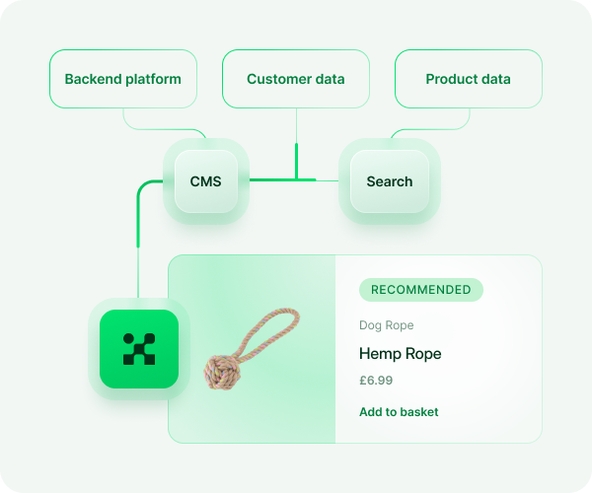
While each module works independently, the orchestration layer ensures that all the necessary modules receive the appropriate signal. A single click may require responses from multiple APIs, and this layer ensures that all of them get the required signal.
Easy collaboration & integration with composable tools
FEaaS has integrations that easily connect to ecommerce platforms and other elements of composable architecture such as headless CMSs, search, and recommendation systems.
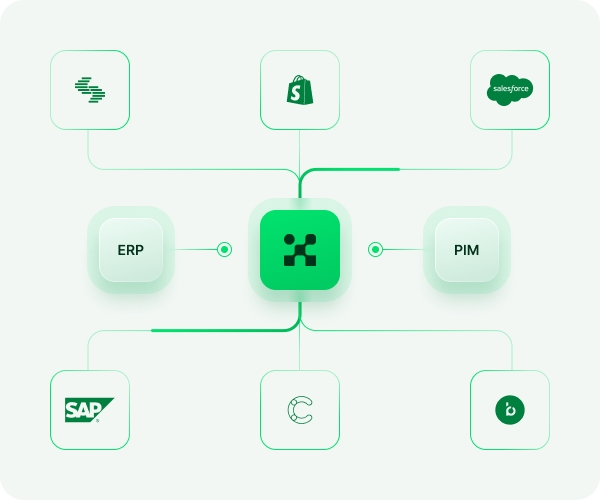
Your FEaaS solution makes it easy for your developers to add all third-party integrations needed for a comprehensive tech stack. These integrations can include a custom system developed by your team to handle in-store and online stock and more. They also enable you to easily integrate loyalty and other services you need to offer optimal customer experience.
Production-ready cloud infrastructure
FEaaS solutions also come with fewer headaches and reduced strain on hosting as everything is in the Cloud. This way, you can enjoy simplified maintenance as well some additional benefits of cloud infrastructure:
- Increased server uptime;
- Scalability of resources;
- Lower TCO (cutting DevOps & SecOps costs);
- Increased security;
- Location independence;
- Facilitated team collaboration;
- Backup and disaster recovery.
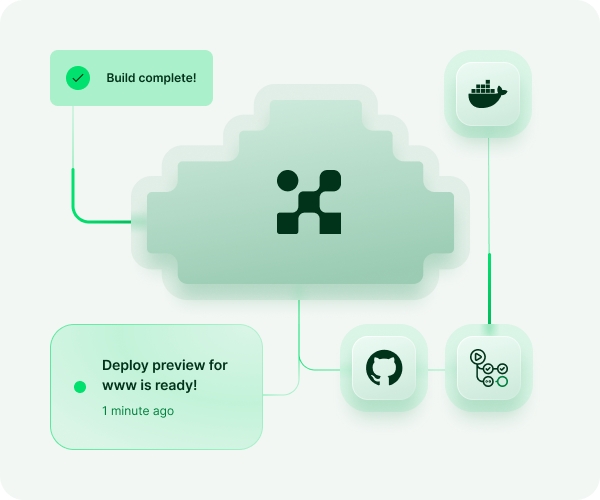
Consistent performance support
Since building and supporting an eneterprise-grade frontend is not an easy job, Frontend as a Service solutions come with another great perk – a dedicated Customer Success Manager. They support you with code reviews, web performance optimizations, or guidance in terms of the best vendors for your business needs.
You should look for a consistent partner who watches and monitors your site's performance with every release. Lastly, developer support is also important to ensure a smooth migration or replatforming process.
Advantages of using Frontend as a Service
There are many reasons to rely on Frontend as a Service:
Faster development & time to market: Rather than building from scratch, your developers can create your website or application in significantly less time since they already have all the core elements for frontend development.
Full flexibility: The prebuilt frontend components are fully customizable, which gives developers full freedom to tailor it to their needs and control the end result.
No vendor lock-in: The advantage of a FEaaS solution is that it remains agnostic to vendors, helping your store futureproof. Business owners are free to switch vendors as and when necessary, and they retain ownership of the products they create.
Lower infrastructure costs: Your FEaaS provider can improve your overall spending by offering a well-managed and comprehensive infrastructure solution.
Improved customer experiences: FEaaS solutions offer optimized web performance and facilitated omnichannel presence.
Reduced risk of system failure: Frontend as a Service has a modular approach that treats each microservice as a separate entity. As a result, your entire system won't fail if a single microservice or module does.
Scalability and serviceability: The modular approach allows you to scale a single function or module without affecting others. You can also modify or service any given part of the website when not scaling.
Easy implementation of new or improved functions: The composable approach allows your teams to add the required features in no time.
Affordability: As with all Software as a Service solutions, you only pay for the modules you need, providing you with an affordable website that doesn't leave you paying for unwanted extras.
Since every microservice functions independently while being connected to all the others, it expedites the site's operation and ultimately improves your all-important web performance and SEO.
How does FEaaS work?
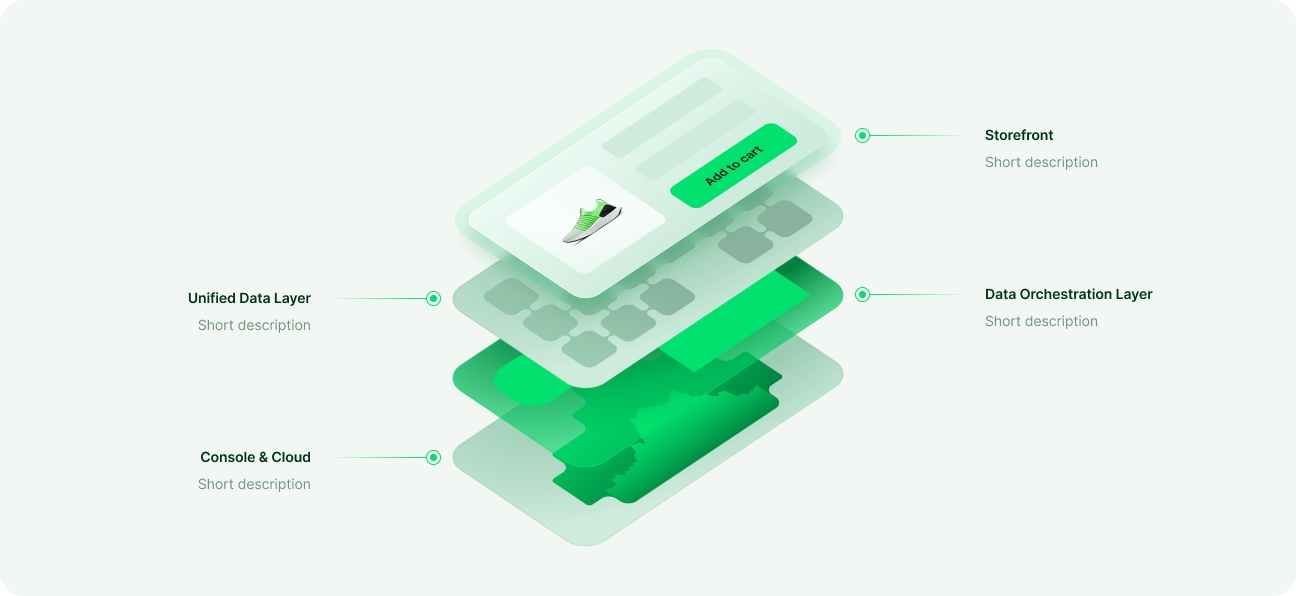
Now that we’ve gone over all of the benefits, it’s time to review the process. In essence, Frontend as a Service is relatively straightforward. From a business perspective, it operates in a few basic steps:
- Step 1: The FEaaS provides prebuilt modules for mobile-first frontend architecture, ready integrations with ecommerce platforms, headless CMS, or other third-party solutions.
- Step 2: Your frontend developers uses the appropriate modules to build a unique and highly customized frontend structure with an excellent user interface for optimal customer experience.
- Step 3: The data orchestration layer ensures that all the modules connect appropriately. From product display to processing carts or displaying relevant content, this tool coordinates all the pieces to function as a unit.
- Step 4: Your customers use your spectacular omnichannel, mobile-first website to look at products, make purchases, and interact with your business.
Frontend as a Service vs. custom development: Key considerations
You may be wondering, why not take your time to develop your own solution? While the choice is entirely in your hands, there are a few things you should consider before moving forward.
Features | FEaaS solution | Custom solution |
Development speed | Fast | Slow |
Budget | Cost-effective long-term strategy | Significant upfront investment |
Updates & maintenance | Provider’s responsibility | Company’s responsibility |
Scalability | Extremely scalable, prepared to adapt to the client’s needs | Difficult to scale, requires additional resources |
Customization | Clients can pick and choose the components they need | The company has to create and customize every component |
Data security & storage | Vendor’s responsibility | Company’s responsibility |
ROI & Time to Market | Fast | Slow |
Third-party integrations | Provider’s responsibility | Time-consuming with security and longevity risks to the overall infrastructure |
Resources | Minimal, a FEaaS solution can be specifically designed for ecommerce needs | Extensive, developing an in-house solution will require additional specialists and time to build the proper infrastructure |
The Alokai FEaaS solution
Alokai offers a complete FEaaS solution for composable commerce – we cover every part of the development process, from build to launch.
Alokai is a Frontend as a Service provider for composable commerce, allowing merchants to focus on what drives revenue and matters most – customer experience. You can connect modern and legacy ecommerce technologies through ready integrations, build with premade frontend components, and deploy on secure, enterprise cloud infrastructure.
It works on multiple stages:
Frontend: Because the customer journey happens on the frontend, you need a fast, mobile-first presentation layer to drive conversion and revenue. With an agnostic ecosystem of integrations and API Orchestration Layer, you can easily pull together your whole composable technology stack in one place. After all, frontend is where the customer experience happens.
Design: Moving your design from your head to your website can be daunting. That’s why Alokai provides a comprehensive open-source design system and library of pre-made frontend components, to help developers quickly build fast, efficient, and beautiful online stores.
Integrations: Turning the modules and microservices you need into a useful website requires an extra step. The Alokai data orchestration layer makes sure that all pieces come together as a functional whole. There are over 20 different types of integration options, including:
Ecommerce platform integrations
Headless CMS integrations
Search integrations
Payment integrations
Custom third-party integrations
Cloud infrastructure: Beyond the mere construction and design of your headless merchant site, Alokai also offers production-ready cloud infrastructure to deploy your ecommerce frontend. You get a cloud that is optimized for speed and for your Alokai technology stack, so there is no further migration needed.
Production & support: Finally, the Alokai team assists you with website launches and maintenance to ensure that your front end stays fast and mobile-friendly. This creates a superb customer experience, resulting in higher conversion rates and revenue.
Alokai's Frontend as a Service ecosystem of tools can help you with the entire process or just one part. Whether you need an independent API or a collaborative system, we're happy to help.













